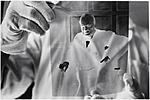I was teached in this forum about Karsh toe usage. Often he placed hair, clothes, chairs (etc) in the film toe. This is documented in the 150,000 negatives he shot.
This important subject has clothes well in the toe:

I guess that in the Pre VC popularization era it was worth compressing shadows in the film toe.
We can compress shadows in the film toe or in the paper shoulder (or in Ps

)... but since VC was popular we have new tools for shadows, like split burning with an arbitrary grade.
Anyway I feel fascinated from the way Karsh worked the toe, so I try to learn a bit that way.



 Reply With Quote
Reply With Quote

 )... but since VC was popular we have new tools for shadows, like split burning with an arbitrary grade.
)... but since VC was popular we have new tools for shadows, like split burning with an arbitrary grade.
Bookmarks